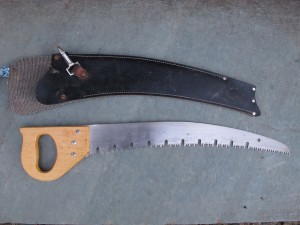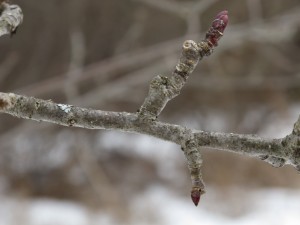It’s Time To Work On Those Old Apple Trees
I recently spent 3 hours in an old wild apple tree, bringing it new life. Apple trees need to be pruned from time to time, and this one had not been worked on for several years. Even wild apples, those planted by birds, can be wonderful additions to the landscape if nicely pruned. The fruit of wild apples is not tasty, but the flowers and form can be a delight to the eye. You can work on apple trees of any kind from now until the buds begin to open. That isn’t until sometime in May, depending on the weather and the variety you grow.
Before discussing how to prune, a few safety reminders are in order. Always wear eye protection when pruning. Safety glasses are best, but sunglasses or prescription glasses are better than nothing. When cutting branches above your head, wear a cap with a brim and try to stand up-wind of the cut. You don’t want to fill your eyes up with sawdust, especially if on a ladder or perched on an upper branch.
Wear gloves and a long-sleeved jacket. Those will help to protect your skin from cuts if the saw slips. As you finish a cut, slow down and reduce pressure on the blade so that the saw will be less likely to surge forward when it finishes the cut. Never steady yourself by holding onto a branch below what you are sawing. Lastly, use good, sharp tools – a dull saw will be a frustration and can be a danger.
I like to walk around a tree several times to study it before I begin to prune. I want to decide which branches I will take out before I begin. If working with someone (which is always good) I like to hear what my co-worker thinks should be removed.
When I teach pruning I tell people that the goal of pruning is to thin out the canopy so that sunshine can get to each leaf. This will also allow for good air circulation which will help to reduce fungal diseases. I like to say a bird should be able to fly through the tree without getting hurt.
Don’t make cuts flush to the trunk or a larger branch. But don’t leave 3 inch stubs, either. Leave the wrinkled bark where the branch originates. That part is the ‘branch collar’ and it is where the branch will heal and scab over.
The tree I pruned recently was mature but healthy; it had no dead branches or signs of disease. Normally I remove dead wood first.
Next, if 2 branches are rubbing or in danger of fusing together (because they are growing so close together), I remove one of them. On this tree, a four-inch diameter branch was rubbing against and fusing with another, so I removed it in a 2-part procedure. First I reduced the weight of the branch by lopping off most of it. This made the finish cut easier. A heavy branch is likely to snap off and tear the bark before the cut is completed.
It was an awkward cut because the branches were so close together. I used a magic marker to draw lines to show me where to cut. This guided me as I angled the saw up to the exact spot I was aiming for as I completed the cut. I used a 21-inch scimitar-shaped pruning saw for the job. It has big teeth that make the job easier than a smaller saw, and unlike a bow saw, it can get in relatively tight places. It is a Corona brand saw, a model RS 7160that I bought from OESCO, a tool supplier in Conway, MA (www.oescoinc.com).
Branches that are at roughly a 45 degree angle from the leader generally produce the most fruit. Vertical shoots, on the other hand, are not very productive and should be removed. They start out as “water sprouts”, little pencil-sized shoots but will grow to be large if not removed. You should snip them off with hand pruners even though they will reappear next summer. However, if you do a good job of opening up the tree to sunlight, you may get fewer of them.
Blossoms and fruit appear on little fruit spurs, generally 3-4 inch twigs with a few larger buds. Fruit grows on spurs that are at least 3 years old. Each bud will produce more than one blossom and a few leaves. If you take a few branches with fruit spurs and place them in a vase, they will eventually bloom inside the house – a real treat for me. Other buds will just produce leaves, but even those are nice at this time of year.
I removed several large branches in the interior of the tree. It’s always a good plan to make a few cuts of larger branches than lots of little cuts. Don’t think of pruning as “cutting off an arm”. Pruning helps the tree to be healthy and to produce more fruit and flowers in future years.
So have at it. Go outside on a sunny day and start pruning. Take your time. Do the easy stuff first. You’ll gain confidence as you go, and, with time, your tree will turn into a piece of art.
Henry Homeyer’s web sites are www.henryhomeyer.com and www.Gardening-Guy.com.





